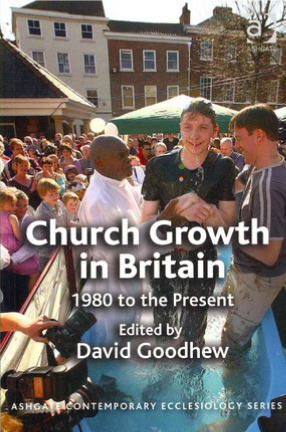Book review: Church Growth in Britain
Church Growth in Britain:1980 to the Present, ed. David Goodhew, Farnham: Ashgate, 2012
It is a widely accepted fact that Christianity in Britain is in terminal decline. The dominant narrative is that widespread secularization is leading inevitably towards, in the words of social historian Callum Brown, The Death of Christian Britain.
A new book on Church Growth in Britain, 1980 to the Present, edited by David Goodhew, Director of Ministerial Practice at Cranmer Hall, Durham (Farnham: Ashgate, 2012) challenges that assumption. The volume is “a mosaic of micro-studies” giving fourteen examples of church growth in denominations and local congregations from across Britain.
Rather than approaching the subject through national and regional statistics of church membership and attendance, Goodhew has looked at church growth “from below”, that is, from the perspective of the local congregation. His book is a powerful challenge to the “hegemonic meta-narrative of secularization”, that local congregations in Britain are in steep decline
Goodhew comes to the following conclusions:
The Christian church in London is growing both in absolute terms and as a proportion of the population.
Most “mainline” denominations have experienced decline but not all, the Baptists having remained more-or-less stable. Weekday worship at Anglican Cathedrals has mushroomed as has involvement in certain Anglican networks such as New Wine.
Black and other ethnic minority churches have experienced sustained growth in recent decades but have made only limited impact on mainline churches and on the majority population
Church planting and other new forms of church are enjoying substantial growth, yet they are glaringly absent from many statistical studies.
The secularization narrative is shown to be a gross simplification. A much more complex picture emerges as one takes into account these hitherto marginalized stories of church growth. Goodhew concludes: “British churches are experiencing both decline and growth. Britain has grown more secular and more religious in the last 30 years”.
“The Christian church in London is growing both in absolute terms and as a proportion of the population.”
Observing the paradox that, in the recent Census, Londoners were the least likely to describe themselves as “Christian” of any region in Britain, yet London’s churches are growing faster than anywhere else in the country, it follows that “a country or city can, at the same time, grow more secular by one measure and less secular by another”.
Though the focus of this volume is self-consciously British, these observations may prove to be applicable across Europe. However, when Goodhew suggests that Britain “straddles the religious divide between the secularity of, say Sweden and the robust religiosity of Ghana” he makes the same mistake that he has been so keen to point out in other treatments of church growth in Britain. Are there not stories of striking church growth “from below” to be told in Sweden? Would not an equally rigorous treatment of Swedish churches, both historic and new, evidence a similar situation of simultaneous growth and decline.
However this merely illustrates Goodhew’s wider point, that “we should cease thinking in terms of a zero-sum game in which society is either becoming more secular or more religious. Rather, parts of Britain and parts of society and culture are growing more secular and other parts are growing less secular”. His comment on Sweden shows just how hard it is to uproot this way of thinking. Yet this is a message that missiologists and church leaders across Europe would do well to heed.
Jim Memory

